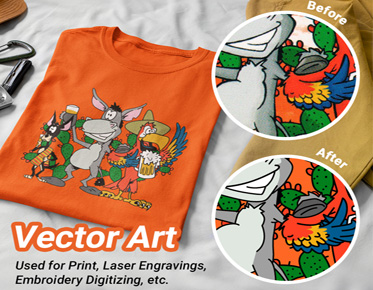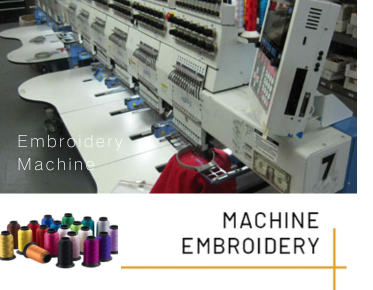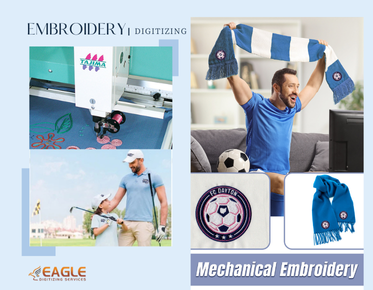Transform Your Packaging with Vector Art for Small Biz
Packaging is more than just a container for products; it's a crucial element of a small business's branding strategy. In a crowded market, where first impressions count, effective packaging can make a significant difference. Vector art, with its precision and adaptability, plays a pivotal role in creating standout packaging designs. This article explores the advantages of vector art in packaging, its impact on small businesses, and how it can elevate your product presentation.
The Importance of Packaging Design for Small Businesses
First Impressions: How Packaging Influences Consumer Choices
Packaging is frequently the first point of contact between a consumer and a product. Eye-catching and well-designed packaging can grab attention and influence purchase decisions. For small businesses, effective packaging design helps differentiate their products in a competitive market, making a memorable first impression that can drive sales.
Branding Through Packaging: Building a Strong Brand Identity
Packaging serves as a powerful branding tool. Consistent use of colors, logos, and design elements helps reinforce brand identity and build recognition. For small businesses, well-designed packaging can create a strong visual presence that resonates with customers and establishes a brand's personality and values.
The Role of Packaging in Product Differentiation
In a crowded marketplace, packaging plays a critical role in differentiating products. Unique and innovative packaging designs help products stand out from competitors and attract consumer interest. Effective packaging can convey key product attributes, such as quality, functionality, and benefits, making it easier for consumers to choose your product over others.
Benefits of Using Vector Art for Packaging
Scalability: Ensuring Quality at Any Size
One of the most notable advantages of vector graphics is its scalability. Whether your packaging design is printed on a small label or a large box, vector graphics ensure that the image remains sharp and clear. This scalability is crucial for maintaining a professional appearance across various packaging formats and sizes.
Precision and Detail: Sharp, Clear Images for Better Presentation
Vector art provides exceptional precision and detail, which is essential for high-quality packaging. Clean lines, well-defined shapes, and intricate details contribute to a polished and professional look. This level of precision enhances the overall presentation of the product and ensures that the packaging effectively communicates its message.
Flexibility: Easy Modifications and Adjustments
Vector graphics offer unparalleled flexibility for making design adjustments. Whether you need to tweak colors, change text, or alter design elements, vector art allows for easy modifications without affecting the overall quality. This flexibility is particularly valuable in the iterative design process, where changes and refinements are often necessary.
File Formats and Compatibility: Working with Various Printing Methods
Vector art is compatible with a wide range of file formats and printing methods, making it versatile for packaging design. Popular formats such as AI, EPS, and PDF ensure that vector graphics can be easily shared with printers and other design professionals. This compatibility helps streamline the production process and ensures that the final packaging meets the required specifications.
Creating Effective Packaging Designs with Vector Art
Understanding Your Target Audience: Designing for Appeal
Designing packaging with your target audience in mind is crucial for effectiveness. Consider the preferences, needs, and behaviors of your customers when creating your design. Vector art allows for detailed and customizable designs that can be tailored to resonate with your audience, enhancing the overall appeal and relevance of your packaging.
Incorporating Brand Elements: Logos, Colors, and Fonts
Effective packaging design should incorporate key brand elements such as logos, colors, and fonts. Vector art enables precise placement and manipulation of these elements, ensuring that your brand identity is consistently represented. By integrating brand elements seamlessly, you reinforce your brand's image and create a cohesive look across all packaging.
Designing for Functionality: Easy-to-Open and Use Packaging
In addition to aesthetics, packaging design must consider functionality. Ensure that your packaging is easy to open, use, and dispose of. Vector art allows for precise design of functional features such as perforations, resealable closures, and ergonomic handles, enhancing the user experience and practicality of your packaging.
Balancing Aesthetics and Practicality: Making Your Design Work in the Real World
Striking the right balance between aesthetics and practicality is essential for successful packaging design. While visual appeal is important, the packaging must also be functional and practical for its intended use. Vector art provides the tools to create visually stunning designs that also meet practical requirements, resulting in packaging that is both attractive and effective.
The Design Process: From Concept to Finished Product
Brainstorming and Sketching: Starting with Ideas
The design process begins with brainstorming and sketching, where initial ideas and concepts are explored. Sketching helps visualize design concepts and serves as a foundation for further development. Vector art comes into play as these concepts are refined and developed into detailed digital designs.
Digital Design Tools: Popular Software for Vector Art
Several digital design tools are popular for creating vector art. Adobe Illustrator, CorelDRAW, and Inkscape are widely used for their robust vector graphic capabilities. These tools provide a range of features for designing, editing, and finalizing packaging graphics, ensuring that your design meets professional standards.
Iteration and Feedback: Refining Your Design
Designing packaging is an iterative process that involves refining and improving the initial concept based on feedback. Collect input from stakeholders, conduct tests, and make adjustments to enhance the design. Vector art facilitates this process by allowing easy modifications and updates to the design.
Preparing Files for Print: Ensuring Quality and Compatibility
Once the design is finalized, preparing files for print is crucial for ensuring quality and compatibility. Ensure that your vector files are correctly formatted and meet the specifications of your printer. Proper preparation helps avoid issues during production and ensures that the final packaging accurately reflects the design.
Packaging Trends and Innovations for Small Businesses
Current Trends in Packaging Design
Packaging design trends evolve, reflecting changes in consumer preferences and technological advancements. Stay informed about current trends to ensure that your packaging remains relevant and appealing. Trends such as minimalist design, bold typography, and interactive elements can enhance your packaging's impact.
Innovative Packaging Solutions: Functional and Aesthetic Enhancements
Innovative packaging solutions combine functionality and aesthetics to improve user experience. Examples include resealable pouches, smart packaging with QR codes, and unique structural designs. Vector art supports the creation of these innovative solutions, helping your packaging stand out and meet consumer needs.
Eco-Friendly and Sustainable Packaging Trends
Sustainability is increasingly important in packaging design. Trends include the use of recycled materials, biodegradable options, and energy-efficient production processes. Vector art allows for the design of eco-friendly packaging that aligns with these trends and demonstrates your commitment to environmental responsibility.
Customization and Personalization: Meeting Consumer Demands
Customization and customization are major trends in packaging design. Offering personalized packaging options can enhance customer engagement and loyalty. Vector art enables the creation of custom designs that cater to individual preferences and provide a unique experience for your customers.
Legal Considerations for Packaging Design
Understanding Copyright and Trademark Issues
Packaging design must adhere to copyright and trademark regulations to protect intellectual property. Ensure that your design does not infringe on existing copyrights or trademarks. Registering your design and securing trademarks can help safeguard your brand and prevent legal disputes.
Ensuring Compliance with Labeling Regulations
Compliance with labeling regulations is essential for legal and ethical packaging design. Familiarize yourself with industry standards and regulations related to product labeling, including ingredient lists, nutritional information, and safety warnings. Vector art can help create clear and accurate labels that meet regulatory requirements.
Protecting Your Design: Copyright and Intellectual Property
Protecting your packaging design through copyright and intellectual property rights helps prevent unauthorized use and reproduction. Register your design with relevant authorities to secure legal protection. This ensures that your unique packaging design remains exclusively yours and adds value to your brand.
Common Mistakes to Avoid in Packaging Design
Overcomplicating the Design: Keeping It Simple and Effective
Simplicity is key to effective packaging design. Avoid overcomplicating your design with excessive details or clutter. A clean and straightforward design ensures that your message is clear and your packaging remains visually appealing and functional.
Ignoring Practical Aspects: Designing for Usability
Practical aspects of packaging design should not be overlooked. Ensure that your packaging is user-friendly, easy to open, and functional. Vector art allows for detailed design adjustments that address practical considerations, enhancing the overall usability of your packaging.
Failing to Test Designs: The Importance of Prototypes
Testing your packaging design with prototypes is crucial for identifying potential issues and ensuring functionality. Create prototypes to evaluate the design’s effectiveness and make necessary adjustments before final production. This step helps avoid costly mistakes and ensures that the final product meets your expectations.
Neglecting Brand Consistency: Maintaining a Unified Brand Image
Consistency is essential for building a strong brand image. Ensure that your packaging design aligns with your brand’s identity and maintains a cohesive look across all products. Vector art supports brand consistency by allowing precise control over design elements and ensuring that your packaging reflects your brand’s values.
Cost Considerations: Budgeting for Packaging Design
Understanding the Costs Involved in Packaging Design
Packaging design costs can vary widely depending on factors such as complexity, materials, and designer expertise. Understanding the different components of the cost, including design fees, printing expenses, and materials, helps you budget effectively and avoid unexpected expenses.
Balancing Quality and Affordability
Balancing quality and affordability is crucial for successful packaging design. While it’s important to invest in high-quality design and materials, look for cost-effective options that fit within your budget. Prioritize elements that enhance the overall impact of your packaging and deliver the best value.
Investing in Good Design: How It Pays Off in the Long Run
Investing in high-quality packaging design can pay off in the long run by improving product appeal and driving sales. Well-designed packaging enhances brand perception, attracts consumers, and differentiates your product in the market. Consider packaging design as a valuable investment that contributes to your business’s success.
Vector art is a powerful tool in packaging design, offering scalability, precision, and flexibility that are crucial for creating standout packaging. For small businesses, effective packaging design can significantly impact brand identity, consumer perception, and product differentiation. By leveraging the advantages of vector artwork, small businesses can create packaging that not only enhances their products but also drives success in a competitive market. With thoughtful design and strategic use of vector graphics, packaging becomes a key component in building a strong and memorable brand.



